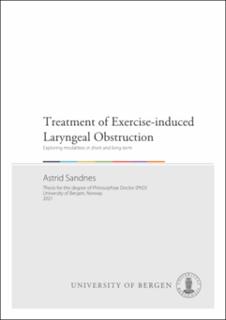Treatment of Exercise-induced Laryngeal Obstruction : Exploring modalities in short and long term
Doctoral thesis
Permanent lenke
https://hdl.handle.net/11250/2740209Utgivelsesdato
2021-05-07Metadata
Vis full innførselSamlinger
Sammendrag
Background: Exercise-induced laryngeal obstruction (EILO) is an umbrella term describing inappropriate and transient closure of laryngeal structures during exercise, causing breathlessness and/or noisy respiration (stridor). EILO is a relatively prevalent entity, affecting adolescents or young adults in all activity levels. The condition has been reported to have a considerable functional impact, particularly as a limitation of physical activity in an effort to minimize the occurrence and severity of inspiratory symptoms. Objective visualization of the laryngeal obstruction and determining the level of obstruction within the larynx (supraglottic and/or glottic) during ongoing exercise is considered gold-standard for diagnosing EILO and seems of importance for subsequent treatment planning. Treatment options are based on weak evidence, with evaluation of different modalities mainly based on subjective outcomes. Information about the diagnosis and breathing advice (IBA) seems to be fundamental elements. Small studies and case reports suggests effect from speech therapy, biofeedback, inspiratory muscle training (IMT) and surgical supraglottoplasty. Robust treatment algorithms and follow-up streams are yet to be established.
Aims: The overall aim of the thesis was to explore improvement of symptoms and laryngeal obstruction in EILO patients treated with IMT and supraglottoplasty in short- and long term. Study #I: To investigate laryngeal response pattern(s) during inspiratory muscle training (IMT) in healthy subjects using laryngoscopic evaluation and imaging. Study #II: To expand our knowledge and to explore possible effects from inspiratory muscle training in patients diagnosed with EILO. Study #III: To investigate the efficacy and safety of laser supraglottoplasty for patients with supraglottic EILO, using continuous laryngoscopy exercise (CLE) tests before and after surgery. Study #IV: To assess changes of self-reported symptoms and laryngeal outcomes shortly after IMT, and to compare self-reported symptoms with a control group 4-6 years later.
Methods: Study design: An explorative approach with combined descriptive and quasi-experimental observational design. Study #I: cross-sectional study, Study #II: prospective pre-post study Study #III: retrospective pre-post study. Study #IV: follow-up study. Subjects and study procedures: Study #I: Twenty healthy volunteers examined with laryngoscopy during inspiratory muscle training (IMT). The laryngeal movements were retrospectively assessed from video files. Study# II and #III: EILO patients examined with continuous laryngoscopy exercise (CLE)-test before and after a treatment; six-week training program with IMT or supraglottoplasty. Outcome data were self-reported symptom scores and laryngeal obstruction (by CLE-scores from video recordings). Study #IV: Two groups were retrospectively identified from the EILO-register; one group receiving IBA only at diagnosis, and the other additionally receiving six weeks of IMT (IBA+IMT). Laryngeal outcome was assessed shortly after IMT, and the two groups’ self-reported symptoms were compared with a new questionnaire 4-6 years later.
Results: Study #I: IMT facilitated laryngeal abduction in the investigated healthy subjects and application of medium intensity resistance seemed superior to higher resistance in opening of the laryngeal aperture. Study #II: IMT was safe and the perceived symptoms and laryngeal obstruction improved in subgroups of EILO after IMT, with improvement mainly observed at the glottic level. Study #III: Supraglottoplasty improved symptoms and reduced laryngeal obstruction in the investigated patients with predominantly supraglottic EILO and appeared safe in highly selected severe cases. Notably, supraglottoplasty might improve also glottic obstruction in patients with combined supraglottic and glottic obstruction. Study #IV: The response rate after 4-6 years was 40 % in the IBA-group and 55% in IBA+IMT-group. After 2-4 weeks, 23/32 in the IBA+IMT-group reported symptom improvements, associated mainly with glottic changes, contrasting unchanged laryngeal scores in 9/32 without symptom improvements. After 4-6 years, self-reported exercise-related symptoms and activity had decreased to similar levels in both groups. Full symptom resolution was reported by 8/55.
Conclusion: Self-reported symptoms and laryngeal obstruction as observed and rated in CLE-tests can improve in EILO patients treated with IBA, IMT or supraglottoplasty. Heterogeneous responses to treatment were observed and substantiates that EILO is a heterogeneous condition, thus it is unlikely that one mode of treatment will work in all. Individual treatment and follow-up based on laryngeal findings seems essential.
Future controlled studies with longer follow-up time are needed to establish effects from the treatment modalities applied in EILO patients. This work provides hypotheses that may serve as a basis in doing so.
Består av
Study #I: Laryngeal movements during inspiratory muscle training in healthy subjects. Sandnes A, Andersen T, Hilland M, Ellingsen TA, Halvorsen T, Heimdal JH, Røksund OD. Journal of Voice. 2013 Jul;27(4):448-453. The article is available in the thesis. The article is also available at: https://doi.org/10.1016/j.jvoice.2013.02.010Study #II: Exercise-induced laryngeal obstruction in athletes treated with inspiratory muscle training. Sandnes A, Andersen T, Clemm HH, Hilland M, Vollsæter M, Heimdal JH, Eide GE, Halvorsen T, Røksund OD. BMJ Open Sport Exerc Med. 2019 Jan 18;5(1):e000436. The article is available at: https://hdl.handle.net/1956/20694
Study #III: Severe exercise-induced laryngeal obstruction treated with supraglottoplasty. Sandnes A, Hilland M, Vollsæter M, Andersen T, Engesæter IØ, Sandvik L, Heimdal JH, Halvorsen T, Eide GE, Røksund OD, Clemm HH. Front Surg. 2019 Jul 31;6:44. The article is available at: https://hdl.handle.net/1956/22719
Study #IV: Clinical responses following inspiratory muscle training in exercise-induced laryngeal obstruction. Sandnes A, Andersen T, Clemm HH, Hilland M, Vollsæter M, Heimdal JH, Halvorsen T, Røksund OD. The article is not available in BORA.
